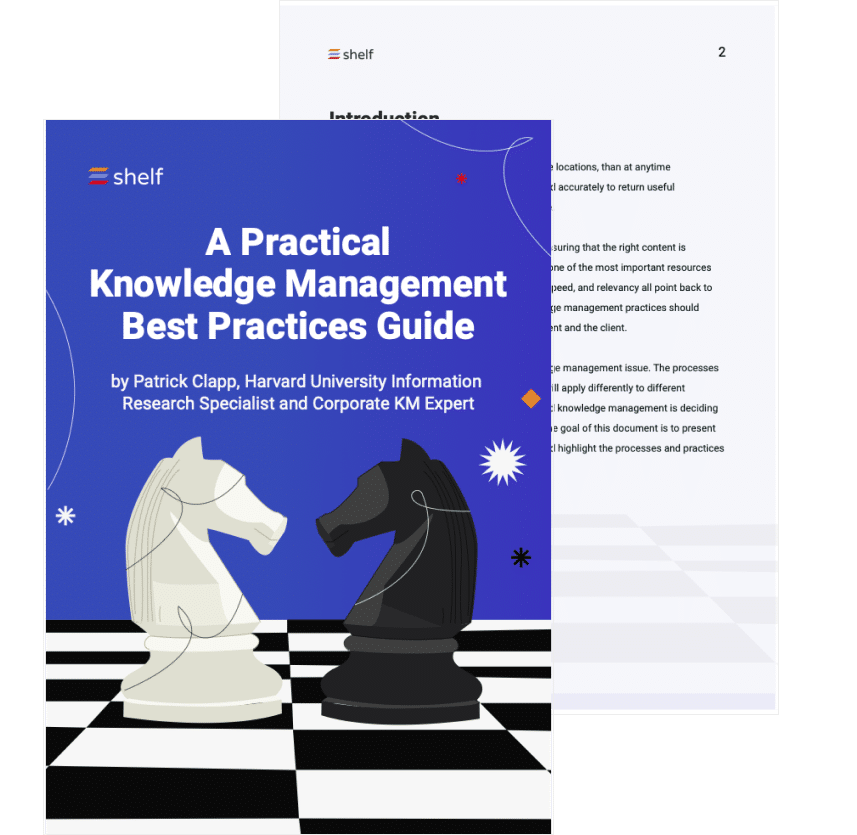You want to make knowledge valuable—in the hands of those who need it—but you need the right company culture to make knowledge an ROI-positive investment. Whether it’s a how-to article a customer needs to solve their own problem or tips from your best salesperson before they retire, there’s no doubt knowledge sharing is valuable.
Everyone in your organization has valuable knowledge that can benefit others, but great customer experiences happen when customers get great answers. Great answers start with a knowledge sharing or knowledge documentation culture to translate sticky notes into usable FAQs or wikis.
As a refresher, there are several different types of knowledge to capture and share, including:
- Explicit knowledge, which is written down and easily accessible and shareable
- Implicit knowledge, which is the practical application of detailed knowledge that’s rooted in real-life situations
- Tacit knowledge, which is the knowledge that’s gained from experience and can be harder to share
Knowledge capture (or sharing) is the starting point for any knowledge management strategy—a concept you must address and take seriously for your organization to thrive in today’s information-rich age.
3 benefits of knowledge sharing
If you are new to the concept of knowledge sharing (or don’t yet have the buy-in you need from executives to support your next initiative) today we’ll cover three benefits to review with your team.
1Building a knowledge base
All organizations, from small companies to large enterprises, need to capture knowledge as the first step to creating an internal knowledge base. Small companies need organized access to knowledge to improve efficiency.
For enterprises using knowledge management platforms, knowledge sharing expands to include integrating customer and employee feedback.
Don’t just share knowledge, organize it
Many companies have knowledge scattered in various places—in people’s heads, even on sticky notes. Sharing is step one, but more importantly you need a way to capture, document, and organize this important information.
As you begin to build out a central knowledge base, you need knowledge processing work to ensure you create valuable knowledge infrastructure—not just articles that live somewhere.
Feedback and knowledge quality
As your company grows, incorporate feedback from the people using your knowledge and create a cycle of constant improvement. Too often, content creators create content in a vacuum without getting feedback from the people who use knowledge the most.
Feedback is critical to keep articles, FAQs, and other content types high quality. Even if you are building a simple knowledge base, you need a feedback loop that relays comments to subject matter experts.
Since knowledge sharing often includes internal or private information, your knowledge base or KB software should have user access controls.
Some answers are okay to expose to public eyes, other types require confidentiality, like:
- Employee benefits, including open enrollment periods and procedures for enrolling
- Onboarding information for new employees
- IT help, including self-service and procedures for requesting full service
- Information about your company’s organizational structure
- Compensation information, including self-service options
- Market research regarding customers, products, and services
Other types of knowledge you may need to share with customers, like:
- Directions for using your products or getting the most out of your services
- FAQs
- Video demonstrations
- Case studies
- How-to articles
- Tutorials
- Customer-created content
Before you publish any kind of knowledge, always ensure your knowledge solution can organize and segment knowledge properly based on the intended audience.
2Creating a community
Knowledge sharing doesn’t involve only employees adding to or tweaking knowledge base articles.
When you encourage knowledge sharing outside of your internal team, you’ll start to build a community among your customers. Your most valuable customer advocates need an outlet to share important information.
Knowledge sharing within a community setting is also a great way to improve your products and services by giving input and feedback.
Although your knowledge base should only contain vetted content, offer an easy way for your customers to leave feedback for your team to review—like simple thumbs up or thumbs down below articles, or a way to add a few lines of text. You can either use a customer self-service portal or create a customer forum as an outlet for your customers to share information.
Whenever customers share valuable knowledge and insight (no matter the outlet), you need a process to include this feedback in your knowledge management process.
.
3Maintaining up-to-date content
As your knowledge base matures, encourage customers and employees to leave ratings and feedback; this simple practice is essential to maintain quality knowledge.
You need a defined process to ensure knowledge can be trusted, a feedback loop. This feedback process is especially important if you surface knowledge within customer-facing support channels like live chat and customers expect the answer to be correct.
Many knowledge bases don’t have great feedback and maintenance features; for knowledge sharing to truly improve content, ensure your knowledge management tool’s backend has a good way to process comments and ratings on documents, wikis, or other content.
Enterprise knowledge management platforms will include these advanced knowledge maintenance features knowledge bases lack.
Create a knowledge sharing culture—View knowledge as infrastructure
If you currently need content to populate your knowledge base, or you need to improve existing content, find a knowledge management tool that includes both sharing and maintenance capabilities.
Many solutions that offer the benefits of knowledge sharing do integrate with communication channels like Teams or Slack, but that doesn’t necessarily mean they are ideal for enterprises. Always ensure your main knowledge management tool can keep content helpful and up-to-date.
A lot of work is involved to keep knowledge maintained—which is why we’re seeing enterprises turn to automation to process all the knowledge-related data coming from sharing information and feedback.
Knowledge is already too big of a challenge to manage with humans…the next phase of knowledge management will look to solve these problems knowledge managers have dealt with for years.





